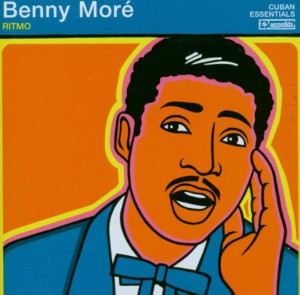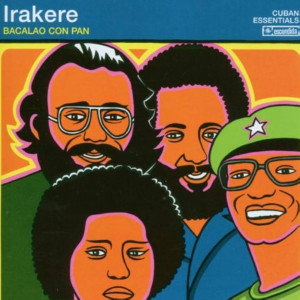 The Escondida label continues its releases under the Cuban Essentials title, highlighting some of the best music and musicians from the vaults of the Cuban state recording studios, EGREM. Begun in 2005 with career overviews of some of the famed members of the “Buena Vista Social Club,” the series in 2006 delves into some other essential artists from Cuba’s past and present.
The Escondida label continues its releases under the Cuban Essentials title, highlighting some of the best music and musicians from the vaults of the Cuban state recording studios, EGREM. Begun in 2005 with career overviews of some of the famed members of the “Buena Vista Social Club,” the series in 2006 delves into some other essential artists from Cuba’s past and present.
Benny Moré was one of the most influential of Cuban bandleaders and singers of the 20th Century, and is hailed as the island nation’s greatest interpreter of songs. With his fluid tenor and unerring sense of rhythm, he placed many different Cuban and Latin American song styles — son, bolero, guaracha and more — in a big band setting. Ritmo gives 15 examples of his work, recorded from the late 1940s to the late ’50s. It includes the ultra romantic ballads “Dolor y Perdon” and the standard-setting “Mucho Corazon,” as well as hip-swaying rumbas like “Maracaibo Oriental” and “Romberos de Ayer.” Americans of a certain will recognize this style from a  certain sit-com of the period: lots of percussion, syncopated piano, blaring trumpets and trombones and sweet saxophones.
certain sit-com of the period: lots of percussion, syncopated piano, blaring trumpets and trombones and sweet saxophones.
Juan Formell and his band Los Van Van are a more contemporary group, moving away from the big-band sound into salsa in the 1970s and ’80s. Por Encima del Nivel gives us the progression with 14 tracks, from 1974 through 1992. The 1974 track “Chirrin Chirran” still has some big band elements, with lots of reverb on the vocals and some other elements. By 1987’s “Nosotros Los del Caribe” it was a post-disco salsa sound, with lots of electronic percussion, keyboards and other effects. And by the early ’90s on tracks like “Que Le Den Candela” the sound had returned to a more organic base, rootsy but still suavé. A big sound, with lots of strings, blaring trombones and multi-part harmony vocals, it’s the sound of evolving salsa, and it’ll make you want to move.
Irakere was one of the biggest “supergroups” on the Cuban salsa scene since its formation in the early 1970s through the late 1980s, and its influence remains obvious even today. Led by pianist Jesus “Chucho”  Valdes, it introduced many well-known Cuban musicians who went on to greater renown, including Valdes himself, Arturo Sandoval, Paquito D’Rivera and others.
Valdes, it introduced many well-known Cuban musicians who went on to greater renown, including Valdes himself, Arturo Sandoval, Paquito D’Rivera and others.
Irakere was primarily a dance band, and its danceability shines through on this collection of a baker’s dozen tracks from 1974 through 1985. There’s not a slack track in the bunch, but standouts include their signature song, the title track “Bacalao Con Pan,” with lots of funky wah-wah guitar, fuzz bass, polyrhythmic percussion and soaring vocals; the romantic danzon “Valle de Picadura;” the pulsating, synthesizer-driven “Siete Tazas De Cafe (Seven Cups of Coffee);” and Al Verlane’s driving “Taka Takata.” For a change of pace, there’s Leo Brower’s stirring “Romance,” a solo Spanish-style guitar piece, and a Chucho solo piano  number, “Juan Almeida’s “Este Camino Largo.” Altogether a superb collection of music from a top-notch band.
number, “Juan Almeida’s “Este Camino Largo.” Altogether a superb collection of music from a top-notch band.
Best avoided, unfortunately, is Virtuoso, a “best-of” collection of piano works from Chucho Valdes’ career. It concentrates mostly on late-’90s works, which sound more like what you’d hear in an American piano bar or department-store lobby. The exceptions are the last four pieces on this 15-track collection, all recorded in 1970. All are very jazzy, whether slow bolero like “Dos Perlas Y Un Dolor” or the rumba “Tu Mi Delirio.” Overall, there’s much better piano jazz, Cuban and otherwise, out there.
Rounding off this look at recent EGREM releases from Escondida is the Guantanamera anthology, a delightful disc that touches on some of the  best and best-known Cuban artists and songs from the past half-century. Most of the tracks are various styles of the ubiquitous son style that grew out of itinerant rural music traditions in the early 20th Century. Here it’s represented by such groups as Sierra Maestra, performing “Echale Salsita” on the opening track; Ñico Saquito’s “Cuidadito Compay Gallo,” and the Ignacio Piñero Septet’s “Consuelaté Como Yo,” among others.
best and best-known Cuban artists and songs from the past half-century. Most of the tracks are various styles of the ubiquitous son style that grew out of itinerant rural music traditions in the early 20th Century. Here it’s represented by such groups as Sierra Maestra, performing “Echale Salsita” on the opening track; Ñico Saquito’s “Cuidadito Compay Gallo,” and the Ignacio Piñero Septet’s “Consuelaté Como Yo,” among others.
There are also examples of other popular Cuban styles, such as Orquesta Aragon’s cha-cha “El Bodequero,” and the big-band conjuntos like Beny Moré’s “Santa Isabel De Las Lajas” and Julio Cuevas’ “El Golpe De Bibijagua.” And of course the universally popular title track, “Guajira Guantanamera,” here performed in a swinging version by Joseito Fernandez. With superb music recorded from 1955 to 1990, Guantanamera, aptly subtitled “A Spicy Cocktail Mix,” is a thoroughly enjoyable overview of 20th Century Cuban music.
(Escondida, 2006)
